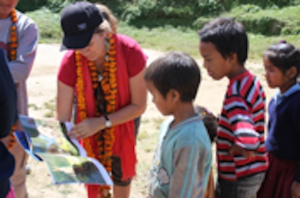Hello and Namaste.
We are Bill and Linda from Australia. We trekked on the Community Trek Trail in 2013.
Prem, our guide, was very experienced and he gave us some great advice: “Walk slowly, take many rests” and so we were happy to move at a comfortable pace that we could sustain. The first leg of the trek is up, up and more up so we greatly appreciated a refreshing masala tea at our destination at the community center at Banskharka village.
I was impressed by the no-plastic policy that forms part of the ecologically sensitive nature of the trek. Water filters at the community centers meant travelers could safely refill their own reusable water bottles and cut down on plastic waste.
Our first night was a home stay. Our hosts were most welcoming and the room was very comfortable. Here we made a modest donation to the school. Chitra, director of the trekking project, had suggested that a world globe would be a useful item so that the children could locate the home country of trekking visitors. Prem had been able to buy one in Pokhara. The students were given writing materials, while the visitors received beautiful garlands of marigolds.
After lunch at the local hall we proceeded to Nangi village, an important center with a high school and a papermaking project. Nangi village is the home village of Prem. Chitra explained that at the end of the trekking season, a meeting is held where the trekking project profits are distributed directly to the local villages that participate in the trekking business.
At Nangi, we stayed in a fine lodge adjacent to a great dining hall built by locals with assistance from UNDP/MEDEP. Nangi village has free wireless Internet at the community centre and the school. The community is justifiably proud of their efforts to connect remote villages with modern technology.
The trek to Mahare Danada was quite challenging but breathtakingly beautiful, too. As we climbed in altitude, the open grasslands gave way to towering forests. Prem woke us the next day to greet the dawn. At 3300 metres, the stunning Annapurnas Mountains are best enjoyed early. The temperature was chilly so our thermals and fleeces were just right, but closer to winter, cold weather apparel would be needed.
The weather closed in and we were walking through misty clouds, which gave way to a sudden downpour. So the final hours of the walk were very damp. We were very glad to arrive at the Mohare Danda guesthouse where a roaring fire welcomed wet and weary trekkers. The guesthouse is a remarkable achievement, given the remoteness of the location. Dozens of people from Nangi village transported all the building materials to establish a facility that provides travelers with comfortable accommodations. There’s a weather station and wireless Internet relay tower all powered by solar electricity. We ate delicious fresh food sourced from the bountiful garden.
We had an easy and short downhill walk to Danda Kharka, where a trekking stop is becoming more established. The fire easily warmed the dining room. Prem produced a deck of cards and taught the visitors a fun new game. The cook did a great job in the kitchen but Linda identified a need for a wooden cooking spoon, which we were able to buy when we got back to Kathmandu. We posted it to Prem who deliver it for us.
After a hearty breakfast, we set off on our final day and passed through some very pretty countryside with hordes of wildflowers on our way to Tikot village. Our destination was unlike Nangi and the other settlements we had visited. Which makes this trek so unique. The village is quite compact, perched on a mountain spur and the farmland below the village is richly cultivated. The hospitality echoed that of the entire trek and we were sad to say farewell.




Leave a Reply